Do you remember the Marie Kondo craze on Netflix on decluttering your home and finding joy? One of the things she talks about is paper.
The endless amounts of paper that you get in the mail and hide in your junk drawer. Or maybe the taxes you file year after year that you store in a file cabinet under lock and key. What about the keepsake items like the drawing your or your kid did when they were in kindergarten?
Whatever it may be, if you haven’t gone paperless, you more than likely have lots of paper sitting around your house or your workspace.
WHAT'S IN THIS POST?
Why Should You Go Paperless?
Paper, A Useful But Wasteful Product, as written by The World Counts talks about the negative impacts paper production has on our environment. To sum it all up, the number of resources needed to produce paper stacked up against its life cycle is detrimental! An A4 size of paper requires 10 liters of water per sheet to produce!
An article written by EPA says the United States generates 67.4 million tons of paper and paperboard materials. While 68% of it is recycled, 17.2 million tons are added to the landfill. It’s great that the majority of paper goods are recycled, but recycling is actually the third pillar of Reduce, Reuse, Recycle. So why aren’t we doing the other two?
With the modern age of technology, the abundant number of libraries in the U.S., and local selling platforms of used goods, getting away from paper might be easier than you think.
What Does It Mean to Go Paperless?
To go paperless sounds a bit daunting when we consider how it is such a huge part of our lives. From the packing materials from convenient online shopping to the printed materials we purchase or use in the office.
In modern society, information is more readily available on the web but we still find ourselves buried in paper.
You often hear the term “paperless” when you think of your bank statements and energy bill. To put it simply, going paperless is to eliminate the tangible end-product by replacing it with its digital format.
The Difference Between Reducing Paper Waste vs Going Paperless
While going paperless is reducing paper waste, it’s not the same the other way around.
Sometimes we find ourselves in situations where there may not be a paperless option. Or maybe we just really love the feel of paper in our hands. If you can’t go paperless, you can try to reduce your paper waste instead.
You can reduce your paper waste by making mindful choices in the items you choose to use or own and how you acquire them. In this post, I’ll share some ideas on how you can reduce your waste and even go paperless if you can.
The Benefits of Going Paperless
You might be thinking reducing your paper waste and even going paperless is great for the environment, but what about me? What does it do for me?
Or maybe you didn’t think that, but there are benefits for you too!
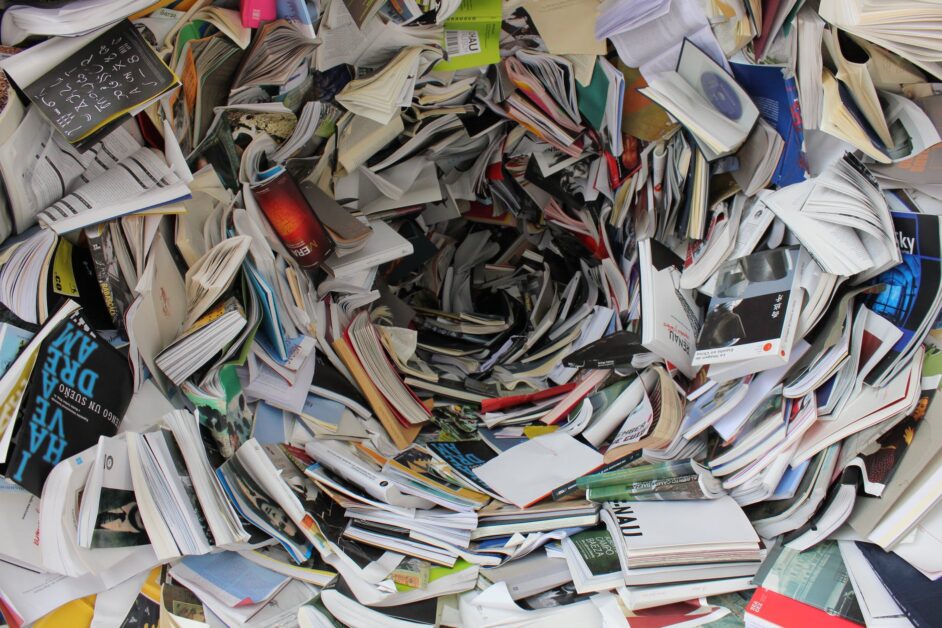
Get Rid of Clutter
Stacks and stacks of paper, while thin, can build into a mountain. Newspapers, junk snail mail, coupons, bills, bank statements, tax forms, home appliance manuals. You name it, there’s probably paper involved somehow.
Just think of how much space or better yet, look at the amount of paper in your own home or office space. Then imagine how much more space you can have if some or all of that paper is gone.

Become More Organized
When you start to declutter the paper mountain by organizing and sorting through the stack you can evaluate what is important. Whatever is worth keeping, you can scan in digital format and save it to an online cloud space, your computer, or mobile device.
In digital format, you may even find things a lot easier through useful search functions available on your computer. Not only does it help reduce the physical clutter in your home or office but your digitized papers can be more useful to you if you can find them.
Easily Accessible
If you store your digital copies on the cloud or in your email, you can access them from anywhere. No cloud? No problem, you can store them on an external hard drive. Many external hard drives nowadays are small and portable. My personal favorite is the Samsung Portable SSD T5, which has 1 TB of storage and is small and lightweight!
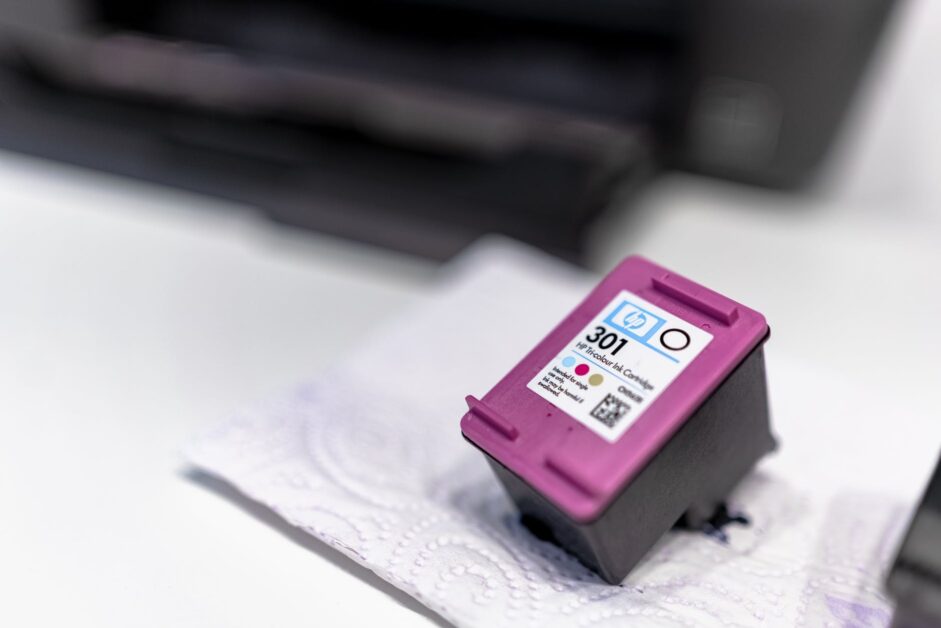
Save Money
If you’re printing documents, you can save money on the ink and paper. Just for black ink cartridges from cartridgeworldusa.com you can spend $60 to $120 a year and color cartridges are more expensive at $75 to $150 per color.
Since the rise in electronic media and the demand for paper products have thankfully declined, interestingly, paper costs are rising! According to IBISWorld, the price of paper has increased 2.9% due to the limited availability of paper production in comparison to the demand.
Reduce Your Carbon Footprint
What goes into paper production involves lots of machine power and deforestation. The pulp and paper industry uses 33-40% of industrial wood globally, with the U.S. being the second-largest producer and consumer in the world (World Wildlife Fund).
This deforestation not only affects neighboring communities but contributes to the negative effects of climate change due to the greenhouse gas emissions. Making pulp and paper also needs a lot of water.
Reducing your paper waste and ultimately going paperless can help reduce your carbon footprint. Forbes even wrote an article on The Sustainable Impact of a Paperless Office if you want to know how it affects the workspace.
How to Go Paperless and Reduce Your Paper Waste
If you’re ready to learn more about how you can incorporate this in your everyday life, keep reading.
#1 Paperless Statements & e-Billing
This one is easy because if you have a bank account or credit card or any type of bill, you most likely have access to it online. Many companies have paperless statements as an option as well as other forms of paperless communication.
Log into your card and bill accounts to see what communication options are available to you and sign up for paperless. If getting a bill or statement in the mail is a reminder of when things are due, try setting up a calendar reminder in your phone instead.
#2 Receipts by Text or Email or not at all
Not all businesses have this option, but some can email or text your receipt to you. If having a receipt is not important to you, opt out by telling the cashier you don’t need a receipt so they won’t print one for you.
If receipts are something you need to have printed, this may be one of those moments where it might be helpful to scan or take a picture of it when you get home so you can get the benefit of not having the paper clutter.
#3 Stop Getting Junk Mail
Did you know that you don’t actually have to get all that junk mail in your mailbox? I hate getting all of the credit card solicitation letters and it’s such a waste of paper!
To opt-out of offers from credit card and insurance companies, check out OptOutPrescreen.com. When you opt-out, your name is no longer provided to these companies. If you opt-out online, it’s only good for 5 years. If you want it to be permanent, you have to send in a request by mail. It may take up to 90 days for it to be effective.
Another way to get less mail is to register at Direct Marketing Association’s (DMA) consumer website, dmachoice.org. From here, you can choose what catalogs, magazines, and other mail you want to get. There is a $2 processing fee, but the registration is good for 10 years.
For more information on how to stop junk mail, check out the FTC Consumer Advice.
#4 Use Online and Mobile Apps
As with advancing technology, many businesses have their own apps. Do you love saving money and using coupons? See if your favorite grocery store has an app; they may have digital coupons that you can “clip and save.”
You can even manage your banking and billing accounts on your mobile devices as well. If you feel secure about the app, you can see your billing statements and even download PDFs to store electronically.
Another useful app are PDF readers and annotators. They let you read PDFs and mark directly on them like you would on printed paper.
#5 Download PDFs
PDFs are universal documents that anyone can open from a mobile device or computer. It’s great because you don’t have to have fancy software to open PDFs and you can even download the Acrobat Reader directly from Adobe for free.
Even if you don’t have the software installed, you can easily install an extension that reads PDFs on your internet browser. There are also mobile and tablet apps that can open PDF for reading and even annotating.
On Little Peace of Happiness, I like to create freebies that are printables and digital products which can be printed or used digitally because they are in PDF format. The benefit of a PDF is that you don’t have to print all of the pages if you don’t need them and you don’t even have to print it out at all.
#6 Scan and Declutter Important Documents
This might take a bit of time and you will reap the rewards when you’re all done. Here are some ideas of paper materials you can either scan, take a picture, or download a PDF version of. Home appliance manuals and warranties
- Car maintenance manuals
- Tax documents
- Receipts
- Bills
- Contracts
- Class notes, lectures, and materials
- Business Cards
There may be some items you want to keep hard copies of, so be sure to read the full post before you start shredding everything!
#7 Electronic Document Signing
Contracts and forms can add up quickly in the home or office and sometimes hard copies of contracts are harder to work with. With the 2020 COVID-19 Pandemic, businesses were trying to figure out how to make their day-to-day seem as normal as possible.
Thankfully for the option of eSignatures, you can now sign documents electronically. In fact, the FDIC allowed the use of electronic signatures since 2000. Here are some electronic signature resources.
You don’t even need fancy electronic signing software if you can find a PDF Annotation tool.
#8 Use E-Books and Audiobooks
Electronic books or e-books and audiobooks are a great alternative to the real thing. You can enjoy a good read without the collection of books taking up space on your shelf or even your backpack if you’re a student. Check out my favorite self-help books in this post here.
Some textbooks are available in electronic format and can be easier to use if you want to write directly on the pages.
If your enjoy the smell of book pages and the feeling of a good book in hand, the next option may work out better.
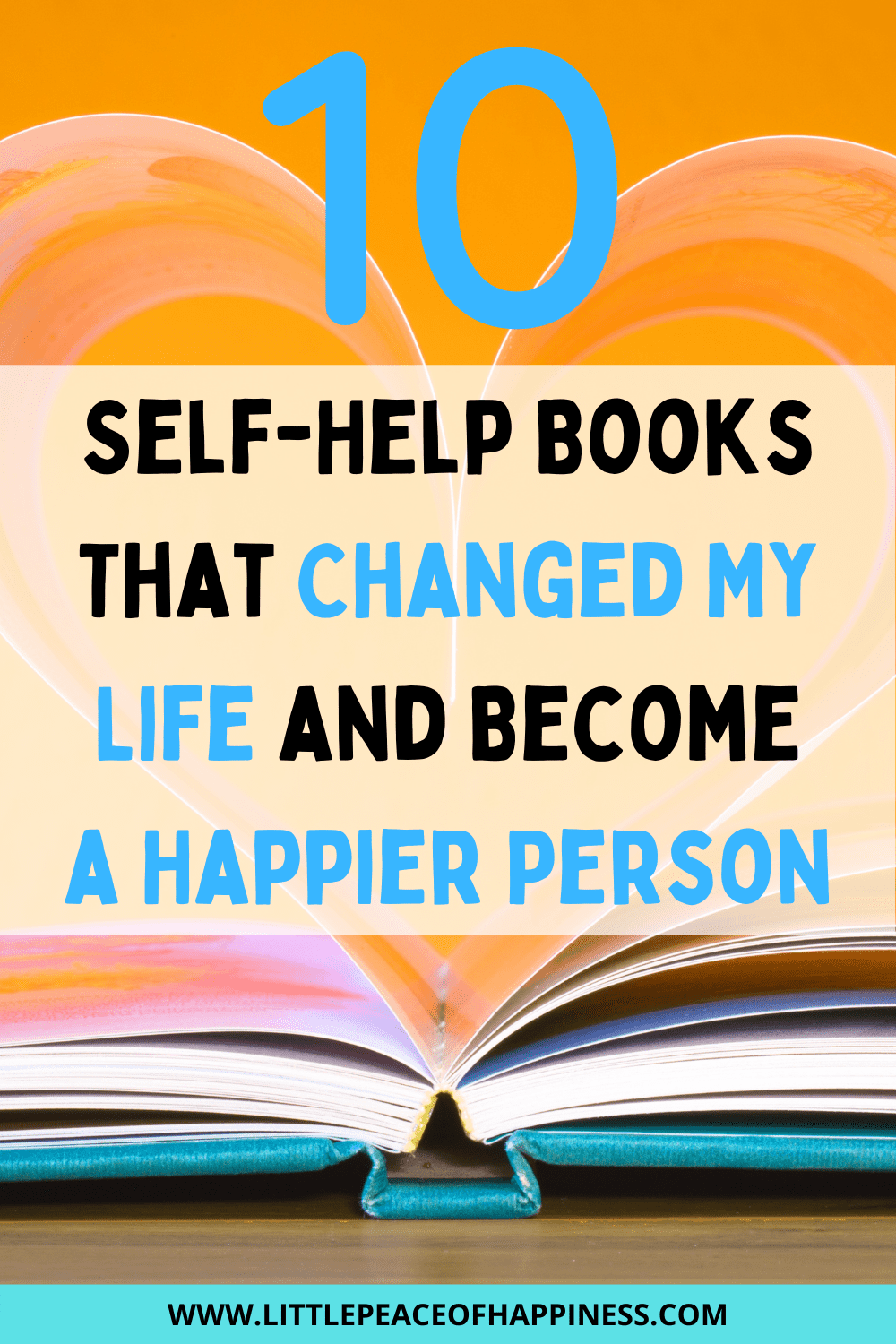
#9 Use Your Local Public Library
If you haven’t been to your local library, you are missing out on some great resources. They’re more than just a place with books. You can benefit from their money managing classes, business startup tips, filing taxes, and even learn how to use basic computer functions.
The library is a great resource of physical books, electronic books, audiobooks, and even peer-reviewed journal articles.
#10 Take Digital Notes
We don’t have to go very far to reach our electronic devices in today’s techy world. With your mobile phone, you can make simple checklists, add calendar events and reminders, and even make notes.
If you need to take notes on a larger screen, a tablet or computer would be the best choice and you can do it easily with Notetaking apps like Noteshelf, Goodnotes, Touchnotes, Xodo, Samsung Notes, etc. If you’re on the computer, you can try OneNote or any other word creation software.
Digital note-taking is becoming more popular with the rise of digital bullet journals, digital notebooks, and even digital planners (like the ones I sell in the shop). Not only does it reduce your paper waste, it give you more freedom and flexibility to insert images, endless pen and marker colors, and in whatever font choice you like!
If you want to learn more about digital planning, check out my post here.
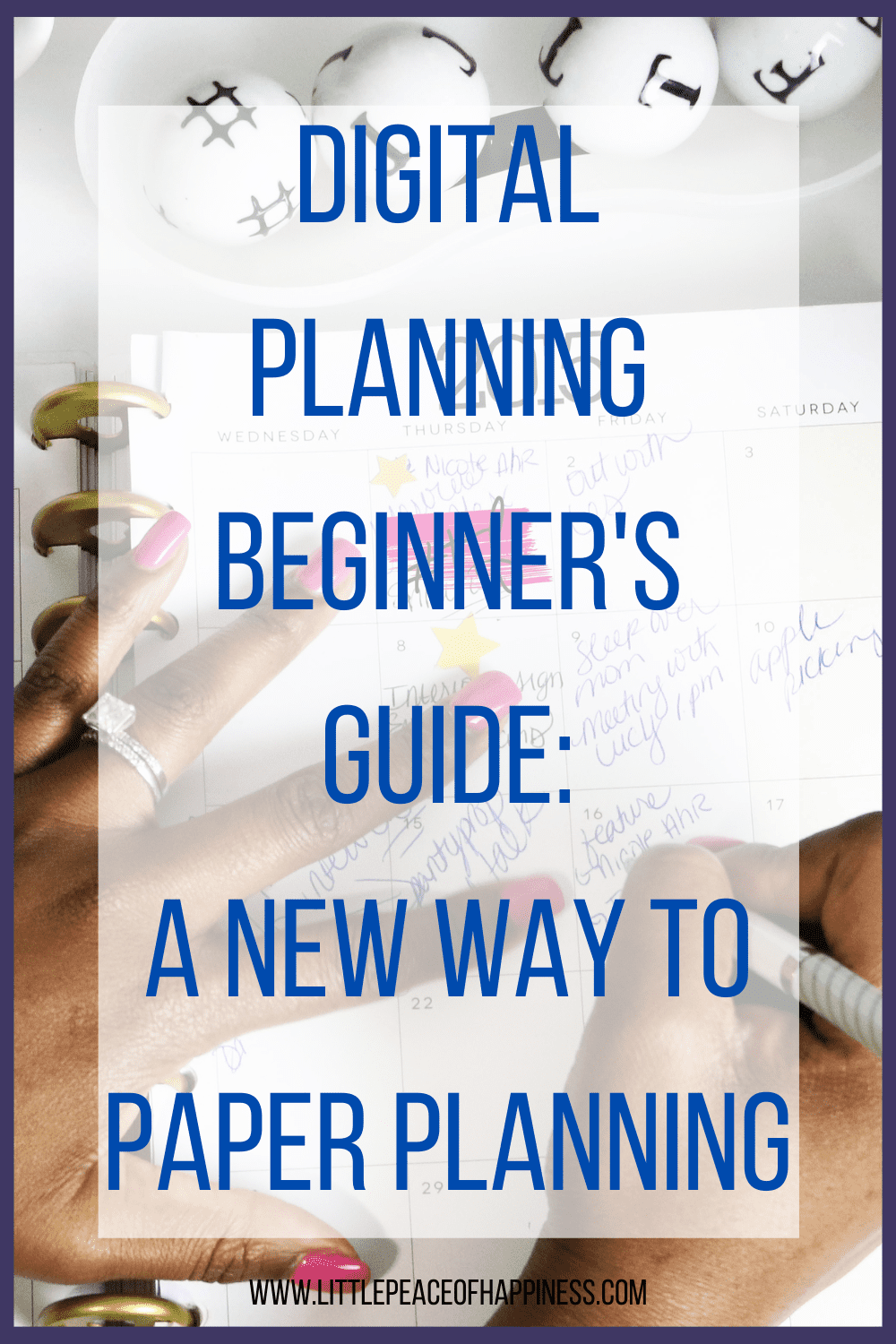
Bonus Tip: Reuse Old Paper and Paperboard Materials
Now that you’ve gone through and decluttered your space and going digital wherever and whenever you can sometime you need a piece of scrap paper to write on when an electronic means is not available. You can cut up that old paper into smaller pieces to make notes on. Another way to prolong the life of the paper and giving it one more useable feature before recycling it.
Old paper can also make a great fire starter if you want that cozy bon fire in the backyard or you’re on your camping trip.
I love upcycling shipping boxes to make storage containers in my home. They’re free, eco-friendly, and you can easily cover them up to make them look a little nicer.
Paper Materials You May Want to Keep on Paper
With all this being said, there are some paper items you may want to keep. Some mementos that don’t have the same sentimental feeling in digital format.
Don’t beat yourself up if you’re not totally paperless. As long as you’re trying in as many aspects of your life that seems feasible, you’re still making a difference.
Sometimes it’s easier to read something that is physically printed, but that doesn’t mean you have to print all the pages or even take a full page. In my post about printing printables, I share ways you can print and be more selective in what and how you’re printing.
Conclusion
In this post you’ve learned how you can go paperless and reduce your paper waste today. Not only will you have more space in your home and office, you’ll feel better about your carbon footprint.
By the end of this post, you’ve become more educated about what going paperless is and what reducing your paper waste actually means. The benefits of reducing paper waste and how easy it is to do. It makes a world of difference to the environment, our own planet earth in fact.
I hope by now I have convinced you or at least raised your interest in the subject matter so you can do your own research on the benefits of going paperless.
Wishing you a Little Peace of Happiness in decluttering your paper stash!

PIN ME!
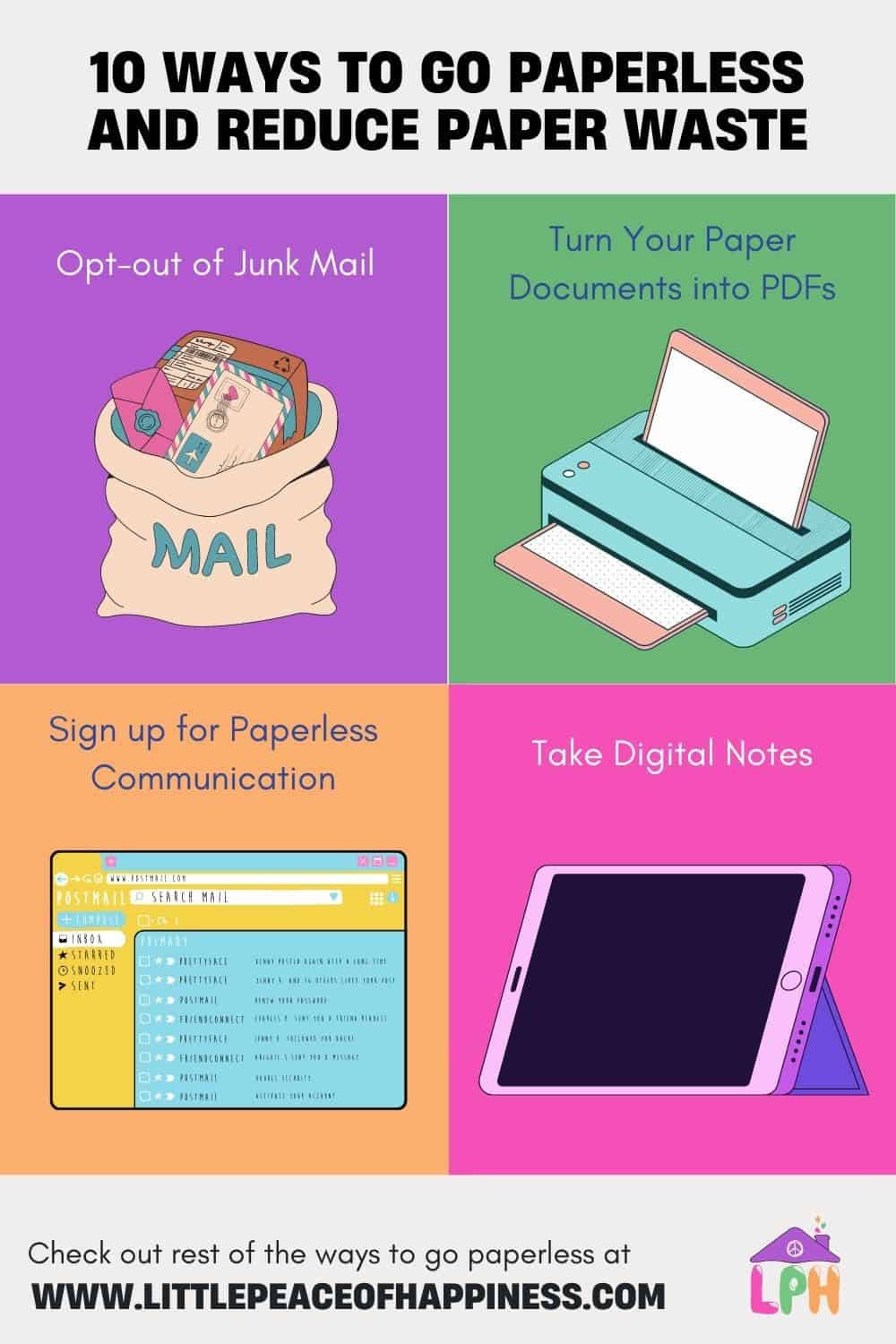

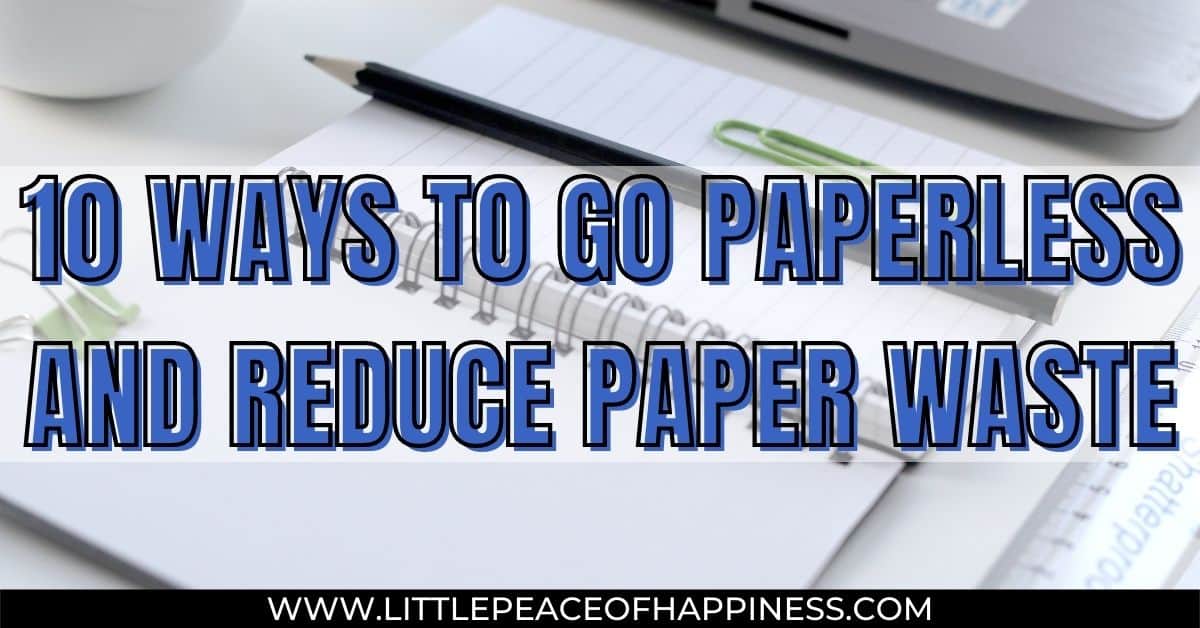

Good luck!
Thanks, I’ve been able to reduce some areas in my life!